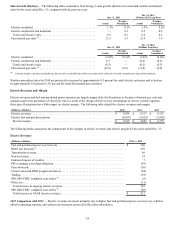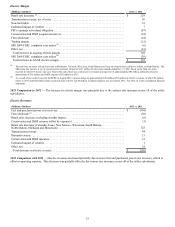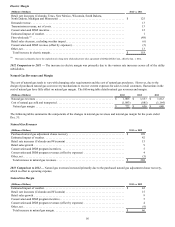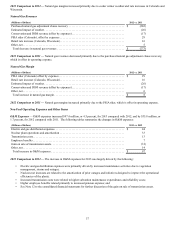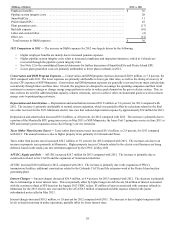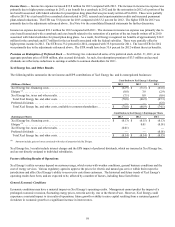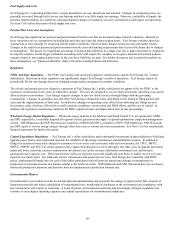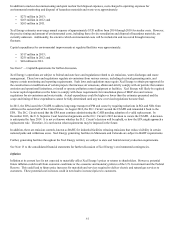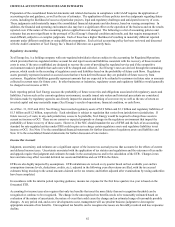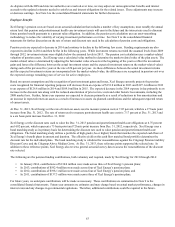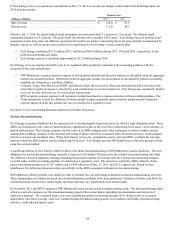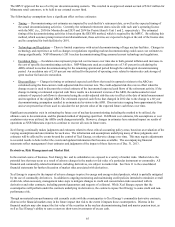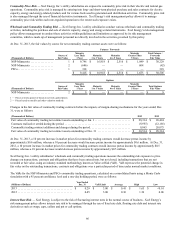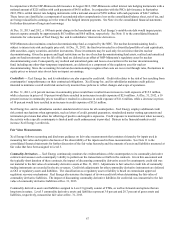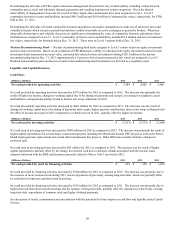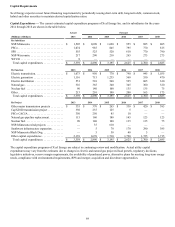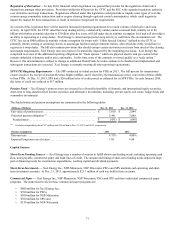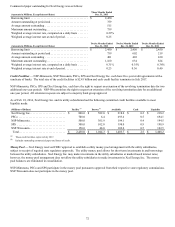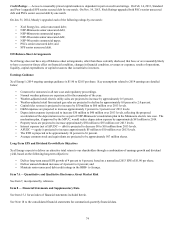Xcel Energy 2013 Annual Report Download - page 82
Download and view the complete annual report
Please find page 82 of the 2013 Xcel Energy annual report below. You can navigate through the pages in the report by either clicking on the pages listed below, or by using the keyword search tool below to find specific information within the annual report.
64
If Xcel Energy were to use alternative assumptions at Dec. 31, 2013, a one-percent change would result in the following impact on
2014 pension expense:
Pension Costs
(Millions of Dollars) +1% -1%
Rate of return. . . . . . . . . . . . . . . . . . . . . . . . . . . . . . . . . . . . . . . . . . . . . . . . $ (25.1) $ 25.5
Discount rate . . . . . . . . . . . . . . . . . . . . . . . . . . . . . . . . . . . . . . . . . . . . . . . . (11.2) 14.1
Effective Jan. 1, 2014, the initial medical trend assumption was decreased from 7.5 percent to 7.0 percent. The ultimate trend
assumption remained at 4.5 percent. The period until the ultimate rate is reached is five years. Xcel Energy bases its medical trend
assumption on the long-term cost inflation expected in the health care market, considering the levels projected and recommended by
industry experts, as well as recent actual medical cost experienced by Xcel Energy’s retiree medical plan.
• Xcel Energy contributed $17.6 million, $47.1 million and $49.0 million during 2013, 2012 and 2011, respectively, to the
postretirement health care plans.
• Xcel Energy expects to contribute approximately $13.3 million during 2014.
Xcel Energy recovers employee benefits costs in its regulated utility operations consistent with accounting guidance with the
exception of the areas noted below.
• NSP-Minnesota recognizes pension expense in all regulatory jurisdictions based on expense as calculated using the aggregate
normal cost actuarial method. Differences between aggregate normal cost and expense as calculated by pension accounting
standards are deferred as a regulatory liability.
• Colorado, Texas, New Mexico and FERC jurisdictions allow the recovery of other post retirement benefit costs only to the
extent that recognized expense is matched by cash contributions to an irrevocable trust. Xcel Energy has consistently funded
at a level to allow full recovery of costs in these jurisdictions.
• SPS recognizes pension expense in all regulatory jurisdictions based on expense consistent with accounting guidance. The
Texas jurisdiction records the difference between annual recognized pension expense and the annual amount of pension
expense approved in the last general rate case as a deferral to a regulatory asset.
See Note 9 to the consolidated financial statements for further discussion.
Nuclear Decommissioning
Xcel Energy recognizes liabilities for the expected cost of retiring tangible long-lived assets for which a legal obligation exists. These
AROs are recognized at fair value as incurred and are capitalized as part of the cost of the related long-lived assets. In the absence of
quoted market prices, Xcel Energy estimates the fair value of its AROs using present value techniques, in which it makes various
assumptions including estimates of the amounts and timing of future cash flows associated with retirement activities, credit-adjusted
risk free rates and cost escalation rates. When Xcel Energy revises any assumptions used to estimate AROs, it adjusts the carrying
amount of both the ARO liability and the related long-lived asset. Xcel Energy accretes ARO liabilities to reflect the passage of time
using the interest method.
A significant portion of Xcel Energy’s AROs relates to the future decommissioning of NSP-Minnesota’s nuclear facilities. The total
obligation for nuclear decommissioning currently is expected to be funded 100 percent by the external decommissioning trust fund.
The difference between regulatory funding (including depreciation expense less returns from the external trust fund) and amounts
recorded under current accounting guidance are deferred as a regulatory asset. The amounts recorded for AROs related to future
nuclear decommissioning were $1,627 million and $1,490 million as of Dec. 31, 2013 and 2012, respectively. Based on their
significance, the following discussion relates specifically to the AROs associated with nuclear decommissioning.
NSP-Minnesota obtains periodic cost studies in order to estimate the cost and timing of planned nuclear decommissioning activities.
These independent cost studies are based on relevant information available at the time performed. Estimates of future cash flows for
extended periods of time are by nature highly uncertain and may vary significantly from actual results.
In November 2012, the MPUC approved NSP-Minnesota’s most recent nuclear decommissioning study. The decommissioning study,
which covered all expenses over the decommissioning period of the nuclear plants, including decontamination and removal of
radioactive material. The estimated future costs were initially determined in nominal amounts (2011 dollars) prior to escalation
adjustments, then future periods’ costs were escalated using decommissioning-specific cost escalators and finally discounted using
risk-free, credit adjusted interest rates.


